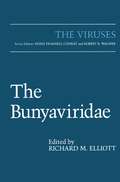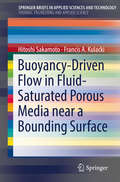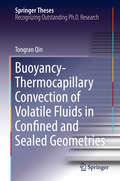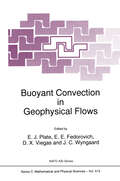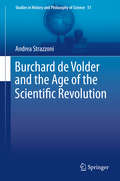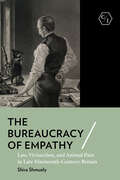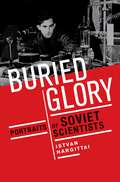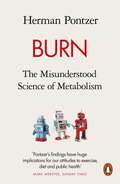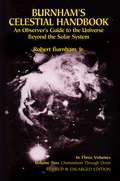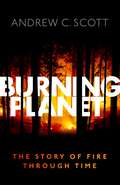- Table View
- List View
The Bundahi%sn: The Zoroastrian Book of Creation
by Domenico Agostini Samuel Thrope Shaul Shaked Guy StroumsaThe Bundahisn, meaning primal or foundational creation, is the central Zoroastrian account of creation, cosmology, and eschatology. Compiled sometime in the ninth century CE, it is one of the most important surviving testaments to Zoroastrian literature in the Middle Persian language and to pre-Islamic Iranian culture. Despite having been composed some two millennia after the Prophet Zoroaster's revelation, it is nonetheless a concise compendium of ancient Zoroastrian knowledge that draws on and reshapes earlier layers of the tradition. Well known in the field of Iranian Studies as an essential primary source for scholars of ancient Iran's history, religions, literatures, and languages, the Bundahisn is also a great work of literature in and of itself, ranking alongside the creation myths of other ancient traditions. The book's thirty-six diverse chapters, which touch on astronomy, eschatology, zoology, medicine, and more, are composed in a variety of styles, registers, and genres, from spare lists and concise commentaries to philosophical discourses and poetic eschatological visions. This new translation, the first in English in nearly a century, highlights the aesthetic quality, literary style, and complexity and raises the profile of pre-Islamic Zoroastrian literature.
Bunsen Burner (tactile)
by Markeaton SchoolThis is an image of a Bunsen Burner on the left of the page connected by a rubber pipe to a gas supply tap on the right of the page.
Buoyancy-Driven Flow in Fluid-Saturated Porous Media near a Bounding Surface (SpringerBriefs in Applied Sciences and Technology)
by Hitoshi Sakamoto Francis A. KulackiThis Brief reports on heat transfer from a solid boundary in a saturated porous medium. Experiments reveal overall heat transfer laws when the flow along the wall is driven by buoyancy produced by large temperature differences, and mathematical analysis using advanced volume-averaging techniques produce estimates of how heat is dispersed in the porous zone. Engineers, hydrologists and geophysicists will find the results valuable for validation of laboratory and field tests, as well as testing their models of dispersion of heat and mass in saturated media.
Buoyancy-Thermocapillary Convection of Volatile Fluids in Confined and Sealed Geometries (Springer Theses)
by Tongran QinThis thesis represents the first systematic description of the two-phase flow problem. Two-phase flows of volatile fluids in confined geometries driven by an applied temperature gradient play an important role in a range of applications, including thermal management, such as heat pipes, thermosyphons, capillary pumped loops and other evaporative cooling devices. Previously, this problem has been addressed using a piecemeal approach that relied heavily on correlations and unproven assumptions, and the science and technology behind heat pipes have barely evolved in recent decades. The model introduced in this thesis, however, presents a comprehensive physically based description of both the liquid and the gas phase.The model has been implemented numerically and successfully validated against the available experimental data, and the numerical results are used to determine the key physical processes that control the heat and mass flow and describe the flow stability. One of the key contributions of this thesis work is the description of the role of noncondensables, such as air, on transport. In particular, it is shown that many of the assumptions used by current engineering models of evaporative cooling devices are based on experiments conducted at atmospheric pressures, and these assumptions break down partially or completely when most of the noncondensables are removed, requiring a new modeling approach presented in the thesis.Moreover, Numerical solutions are used to motivate and justify a simplified analytical description of transport in both the liquid and the gas layer, which can be used to describe flow stability and determine the critical Marangoni number and wavelength describing the onset of the convective pattern. As a result, the results presented in the thesis should be of interest both to engineers working in heat transfer and researchers interested in fluid dynamics and pattern formation.
Buoyant Convection in Geophysical Flows (Nato Science Series C: #513)
by Erich J. Plate E. E. Fedorovich Domingos X. Viegas J. C. WyngaardStudies of convection in geophysical flows constitute an advanced and rapidly developing area of research that is relevant to problems of the natural environment. During the last decade, significant progress has been achieved in the field as a result of both experimental studies and numerical modelling. This led to the principal revision of the widely held view on buoyancy-driven turbulent flows comprising an organised mean component with superimposed chaotic turbulence. An intermediate type of motion, represented by coherent structures, has been found to play a key role in geophysical boundary layers and in larger scale atmospheric and hydrospheric circulations driven by buoyant forcing. New aspects of the interaction between convective motions and rotation have recently been discovered and investigated. Extensive experimental data have also been collected on the role of convection in cloud dynamics and microphysics. New theoretical concepts and approaches have been outlined regarding scaling and parameterization of physical processes in buoyancy-driven geophysical flows. The book summarizes interdisciplinary studies of buoyancy effects in different media (atmosphere and hydrosphere) over a wide range of scales (small scale phenomena in unstably stratified and convectively mixed layers to deep convection in the atmosphere and ocean), by different research methods (field measurements, laboratory simulations, numerical modelling), and within a variety of application areas (dispersion of pollutants, weather forecasting, hazardous phenomena associated with buoyant forcing).
Buprenorphine Therapy of Opiate Addiction (Forensic Science and Medicine)
by Pierre Marquet Pascal KintzIn Buprenorphine Therapy of Opiate Addiction, participating physicians and toxicologists summarize and evaluate their experiences with five years of intensive buprenorphine therapy. They cover all aspects of its use, including the pharmacology, conditions of delivery, risks from use with other psychoactive drugs, toxicology and related deaths, as well as its testing in blood, urine, tissue, and hair. Special attention is given to comparing the long-term care of opiate-dependent patients using high-dose buprenorphine vs methadone, and to explaining the differences in treatment, administration, and delivery. The authors also describe how buprenorphine is currently prescribed and monitored in France and Australia, and review all the latest advances in analytical techniques for the determination of buprenorphine and its metabolites in biological fluids and tissues.
Burchard de Volder and the Age of the Scientific Revolution (Studies in History and Philosophy of Science #51)
by Andrea StrazzoniThis monograph details the entire scientific thought of an influential natural philosopher whose contributions, unfortunately, have become obscured by the pages of history. Readers will discover an important thinker: Burchard de Volder. He was instrumental in founding the first experimental cabinet at a European University in 1675.The author goes beyond the familiar image of De Volder as a forerunner of Newtonianism in Continental Europe. He consults neglected materials, including handwritten sources, and takes into account new historiographical categories. His investigation maps the thought of an author who did not sit with an univocal philosophical school, but critically dealt with all the ‘major’ philosophers and scientists of his age: from Descartes to Newton, via Spinoza, Boyle, Huygens, Bernoulli, and Leibniz. It explores the way De Volder’s un-systematic thought used, rejected, and re-shaped their theories and approaches. In addition, the title includes transcriptions of De Volder's teaching materials: disputations, dictations, and notes.Insightful analysis combined with a trove of primary source material will help readers gain a new perspective on a thinker so far mostly ignored by scholars. They will find a thoughtful figure who engaged with early modern science and developed a place that fostered experimental philosophy.
The Bureaucracy of Empathy: Law, Vivisection, and Animal Pain in Late Nineteenth-Century Britain (Corpus Juris: The Humanities in Politics and Law)
by Shira ShmuelyThe Bureaucracy of Empathy revolves around two central questions: What is pain? And how do we recognize, understand, and ameliorate the pain of nonhuman animals? Shira Shmuely investigates these ethical issues through a close and careful history of the origins, implementation, and enforcement of the 1876 Cruelty to Animals Act of Parliament, which for the first time imposed legal restrictions on animal experimentation and mandated official supervision of procedures "calculated to give pain" to animal subjects.Exploring how scientists, bureaucrats, and lawyers wrestled with the problem of animal pain and its perception, Shmuely traces in depth and detail how the Act was enforced, the medical establishment's initial resistance and then embrace of regulation, and the challenges from anti-vivisection advocates who deemed it insufficient protection against animal suffering. She shows how a "bureaucracy of empathy" emerged to support and administer the legislation, navigating incongruent interpretations of pain. This crucial moment in animal law and ethics continues to inform laws regulating the treatment of nonhuman animals in laboratories, farms, and homes around the worlds to the present.
Bürgerlich-oppositionelle Literaten und sozialdemokratische Arbeiterbewegung nach 1890
by Herbert SchererBürgerliches Recht Schuldrecht, Allgemeiner Teil (Die Wirtschaftswissenschaften #34)
by Karl-Heinz BelowVon den Zweigen des Bürgerlichen Rechts kommt der Wirtschaftswissen schaftler mit dem Recht der Schuldverhältnisse am häufigsten und intensiv sten in Berührung, obwohl nicht alle dort zu behandelnden Fragen für ihn die gleiche Bedeutung haben wie für den Juristen. Diese Umstände stellen dem Verfasser vor allem zwei Aufgaben: Einmal muß eine Darstellung für den Wirtschaftswissenschaftler einen Abriß des gesamten Rechtsstoffes bieten, und zwar in einer leicht faßlichen Art, die zunächst nicht allzuviel juristische Kenntnisse voraussetzt, aber dennoch so prägnant formuliert ist, daß sie wissenschaftlichen Ansprüchen genügt, wo bei sie stets den gegenwärtigen Stand der maßgebenden Meinungen wiedergibt. Sodann ist auf die besonderen Interessen eines Wirtschaftswissenschaftlers Rücksicht zu nehmen. Dies zwingt zu einer Auswahl. Daher werden manche nebensächlichen Fragen in eilender Kürze, zuweilen nur in einem einzigen Satz behandelt, zugunsten der wirklich bedeutsamen Probleme. Immer aber ist zu jedem Fragenkreis die weiterführende Literatur, eingehender als im "Allgemeinen Teil des Bürgerlichen Rechts", zitiert. Ebensowenig fehlt der häufige Hinweis auf wichtige höchstrichterliche Entscheidungen. Zahlreiche Beispiele suchen die Darstellung, der in ihrem Umfang Grenzen gesetzt waren, gerade für die Studierenden der Wirtschaftswissenschaften an schaulich und lebendig zu gestalten. KARL-HEINZ BELOW Inhaltsverzeichnis Seite Einleitung § 1 Der Begriff des Schuldverhältnisses 11 § 2 Quellen und Literatur des Schuldrechts 14 Erstes Kapitel Die Entstehung des Schuldverhältnisses § 3 Allgemeine Schuldentstehungsgründe 17 Der Vertrag § 4 Die Vertragsfreiheit und ihre Begrenzung.
Buried Glory: Portraits of Soviet Scientists
by Istvan HargittaiMoscow's Novodevichy Cemetery is the final resting place of some of Russia's most celebrated figures, from Khrushchev and Yeltsin to Anton Chekhov, Sergei Eisenstein, Nikolai Gogol, and Mikhail Bulgakov. Using this famed cemetery as symbolic starting point, Buried Glory profiles a dozen eminent Soviet scientists-nine of whom are buried at Novodevichy-men who illustrate both the glorious heights of Soviet research as well as the eclipse of science since the collapse of the USSR. Drawing on extensive archival research and his own personal memories, renowned chemist Istvan Hargittai bring these figures back to life, placing their remarkable scientific achievements against the tense political backdrop of the Cold War. Among the eminent scientists profiled here are Petr L. Kapitza, one of the most brilliant representatives of the great generation of Soviet physicists, a Nobel-Prize winner who risked his career-and his life-standing up for fellow scientists against Stalin. Yulii B. Khariton, who ran the highly secretive Soviet nuclear weapons laboratory, Arzamas-16, despite being Jewish and despite the fact that his father Boris had been sent to the labor camps. And Andrei D. Sakharov, the "father of the Soviet hydrogen bomb" and a brilliant fighter for human rights, for which he won the Nobel Peace Prize. Along the way, Hargittai shines a light on the harrowing conditions under which these brilliant researchers excelled. Indeed, in the post-war period, Stalin's anti-Semitism and ongoing anti-science measures devastated biology, damaged chemistry, and nearly destroyed physics. The latter was saved only because Stalin realized that without physics and physicists there could be no nuclear weapons. The extraordinary scientific talent nurtured by the Soviet regime belongs almost entirely to the past. Buried Glory is both a fitting tribute to these great scientists and a fascinating account of scientific work behind the Iron Curtain.
Buried Glory: Portraits of Soviet Scientists
by Istvan HargittaiMoscow's Novodevichy Cemetery is the final resting place of some of Russia's most celebrated figures, from Khrushchev and Yeltsin to Anton Chekhov, Sergei Eisenstein, Nikolai Gogol, and Mikhail Bulgakov. Using this famed cemetery as symbolic starting point, Buried Glory profiles a dozen eminent Soviet scientists-nine of whom are buried at Novodevichy-men who illustrate both the glorious heights of Soviet research as well as the eclipse of science since the collapse of the USSR. Drawing on extensive archival research and his own personal memories, renowned chemist Istvan Hargittai bring these figures back to life, placing their remarkable scientific achievements against the tense political backdrop of the Cold War. Among the eminent scientists profiled here are Petr L. Kapitza, one of the most brilliant representatives of the great generation of Soviet physicists, a Nobel-Prize winner who risked his career-and his life-standing up for fellow scientists against Stalin. Yulii B. Khariton, who ran the highly secretive Soviet nuclear weapons laboratory, Arzamas-16, despite being Jewish and despite the fact that his father Boris had been sent to the labor camps. And Andrei D. Sakharov, the "father of the Soviet hydrogen bomb" and a brilliant fighter for human rights, for which he won the Nobel Peace Prize. Along the way, Hargittai shines a light on the harrowing conditions under which these brilliant researchers excelled. Indeed, in the post-war period, Stalin's anti-Semitism and ongoing anti-science measures devastated biology, damaged chemistry, and nearly destroyed physics. The latter was saved only because Stalin realized that without physics and physicists there could be no nuclear weapons. The extraordinary scientific talent nurtured by the Soviet regime belongs almost entirely to the past. Buried Glory is both a fitting tribute to these great scientists and a fascinating account of scientific work behind the Iron Curtain.
Burn: The Misunderstood Science of Metabolism
by Herman PontzerA myth-busting tour of the body's hidden foundations from a pioneering evolutionary biologistOver the past twenty years, evolutionary biologist Herman Pontzer has conducted ground-breaking studies across a range of settings, including pioneering fieldwork with Hadza hunter-gatherers in northern Tanzania.This book draws on his eye-opening research to show how, contrary to received wisdom, exercise does not increase our metabolism. Instead, we burn calories within a very narrow range: nearly 3,000 calories per day, no matter our activity level.By taking a closer look at what happens to the energy we consume, Pontzer explores the ways in which metabolism controls every aspect of our health - from fertility to immune function - and reveals the truth about the dynamic system that sustains us. Filled with facts and memorable anecdotes, Burn will change the way you think about food, exercise and life.
Burnham's Celestial Handbook: An Observer's Guide to the Universe Beyond the Solar System (Chameleon Through Orion #Volume Two)
by Robert Burnham Jr.Chamaeleon Through OrionWhile there are many books on stars, there is only one Celestial Handbook. Now completely revised through 1977, this unique and necessary reference is available once again to guide amateur and advanced astronomers in their knowledge and enjoyment of the stars. After an extensive introduction in Volume I, which gives the beginner enough information to follow about 80 percent of the body of the material, the author gives comprehensive coverage to the thousands of celestial objects outside our solar system that are within the range of telescopes in the two- to twelve-inch range. The objects are grouped according to the constellations in which they appear. Each constellation is divided into four subject sections: list of double and multiple stars; list of variable stars; list of star clusters, nebulae, and galaxies; and descriptive notes. For each object the author gives names, celestial coordinates, classification, and full physical description. These, together with a star atlas, will help you find and identify almost every object of interest. But the joy of the book is the descriptive notes that follow. They cover history, unusual movements or appearances, and currently accepted explanations of such visible phenomena as white dwarfs, novae and supernovae, cepheids, mira-type variables, dark nebulae, gaseous nebulae, eclipsing binary stars, the large Magellanic cloud, the evolution of a star cluster, and hundreds of other topics, many of which are difficult to find in one place. Hundreds of charts and other visual aids are included to help in identification. Over 300 photographs capture the objects and, in themselves, are works of beauty that reflect the enthusiasm that star gazers have for their subject.
The Burning Answer: A User’s Guide to the Solar Revolution
by Professor Keith BarnhamOur civilisation stands on the brink of catastrophe. Our thirst for energy has led to threats from global warming, nuclear disaster and conflict in oil-rich countries. We are running out of options.Solar power, Keith Barnham argues, is the answer. In this eye-opening book, he shows how a solar revolution is developing based on one of Einstein's lesser known discoveries, one that gave us laptop computers and mobile phones. An accessible guide to renewable technology and a hard-hitting critique of the arguments of solar sceptics, The Burning Answer outlines a future in which the fuel for electric cars will be generated on our rooftops. It is, above all, an impassioned call to arms to join the solar revolution before it's too late.
The Burning Earth: An Environmental History of the Last 500 Years
by Sunil Amrith'Sunil Amrith has given us the most readable global environmental history yet... a towering achievement and a joy to read' - J. R. McNeill'The Burning Earth is as beautiful as it is indispensable, as breathtaking as it is devastating. It answers questions most of us have been too daft even to ask. It will set you on fire' - Jill Lepore, author of These Truths: A History of the United States'A devastating panorama of human folly, a poetic meditation on how the search for freedom from nature undermined the very conditions for life on earth. Beautifully written, Sunil Amrith’s global and long-term view is crucial to understanding the environmental predicaments we are in, and, perhaps, to restore a distraught world. A must read for anyone concerned with the state of the planet' - Sven Beckert, author of Empire of Cotton'Memorable and mesmerizing. Sunil Amrith has gifted us a page-turner of a book, written with passionate lucidity' - Rob Nixon, author of Slow Violence and the Environmentalism of the PoorIn this paradigm-shifting global history of how humanity has reshaped the planet, and the planet has shaped human history, Sunil Amrith twins the stories of environment and Empire, of genocide and eco-cide, of the expansion of human freedom and its costs. Drawing on an extraordinarily rich diversity of primary sources, he reckons with the ruins of Portuguese silver mining in Peru, British gold mining in South Africa, and oil extraction in Central Asia. He explores the railways and highways that brought humans to new terrains of battle against each other and against nature. Amrith’s account of the ways in which the First and Second World Wars involved the massive mobilization not only of men, but of other natural resources from around the globe, provides an essential new way of understanding war as an irreversible reshaping of the planet. He also reveals the reality of migration as consequence of environmental harm.The imperial, globe-spanning pursuit of profit, joined with new forms of energy and new possibilities of freedom from hunger and discomfort, freedom to move and explore, has brought change to every inch of the Earth. Amrith relates, on the largest canvas, a mind-altering epic – vibrant with stories, characters, and vivid images – in which humanity might find the collective wisdom to save itself.
Burning fuels experiment (tactile)
by Sheffield Vi ServiceThis is a labelled diagram of an experiment to show the products of combustion of a gas.
Burning Matters: Life, Labor, and E-Waste Pyropolitics in Ghana (Global and Comparative Ethnography)
by Peter C. LittleGlobal trade in electronic waste (e-waste) has led to various waste management challenges and many regions of the Global South have suffered the toxic consequences. In Burning Matters, Peter C. Little explores the complex cultural, economic, and environmental health politics of e-waste work in Ghana. He brings to light the lived experiences of Ghana's e-waste workers, as they navigate the health, social, and economic challenges of highly toxic e-waste labor. In particular, Little engages the experiences of e-waste workers who burn bundles of electrical cables to extract copper, a practice that contaminates bodies and the urban environment and which has attracted international organizations seeking to mitigate risk and find quick tech solutions to this highly toxic e-waste work. A nuanced perspective on e-waste burning and environmental politics in Africa at a time when global e-waste generation and trade is at an all-time high, Burning Matters contends that e-waste interventions devoid of ethnographic perspective and knowledge risk downplaying the vibrant complexities of e-waste itself and the matters of social life and labor that matter most to Ghana's e-waste workers.
Burning Matters: Life, Labor, and E-Waste Pyropolitics in Ghana (Global and Comparative Ethnography)
by Peter C. LittleGlobal trade in electronic waste (e-waste) has led to various waste management challenges and many regions of the Global South have suffered the toxic consequences. In Burning Matters, Peter C. Little explores the complex cultural, economic, and environmental health politics of e-waste work in Ghana. He brings to light the lived experiences of Ghana's e-waste workers, as they navigate the health, social, and economic challenges of highly toxic e-waste labor. In particular, Little engages the experiences of e-waste workers who burn bundles of electrical cables to extract copper, a practice that contaminates bodies and the urban environment and which has attracted international organizations seeking to mitigate risk and find quick tech solutions to this highly toxic e-waste work. A nuanced perspective on e-waste burning and environmental politics in Africa at a time when global e-waste generation and trade is at an all-time high, Burning Matters contends that e-waste interventions devoid of ethnographic perspective and knowledge risk downplaying the vibrant complexities of e-waste itself and the matters of social life and labor that matter most to Ghana's e-waste workers.
Burning methane experiment (tactile)
by Sheffield Vi ServiceThis is a labelled diagram of an experiment to show the products of combustion of burning methane.
Burning Planet: The Story of Fire Through Time
by Andrew C. ScottRaging wildfires have devastated vast areas of California and Australia in recent years, and predictions are that we will see more of the same in coming years, as a result of climate change. But this is nothing new. Since the dawn of life on land, large-scale fires have played their part in shaping life on Earth. Andrew Scott tells the whole story of fire's impact on our planet's atmosphere, climate, vegetation, ecology, and the evolution of plant and animal life. It has caused mass extinctions, and it has propelled the spread of flowering plants. The exciting evidence we can now draw on has been preserved in fossilized charcoal, found in rocks hundreds of millions of years old, from all over the world. These reveal incredibly fine details of prehistoric plants, and tell us about climates from deep in earth's history. They also give us insight into how early hominids and humans tamed fire and used it. Looking at the impact of wildfires in our own time, Scott also looks forward to how we might better manage them in future, as climate change has an increasing effect on our world.


